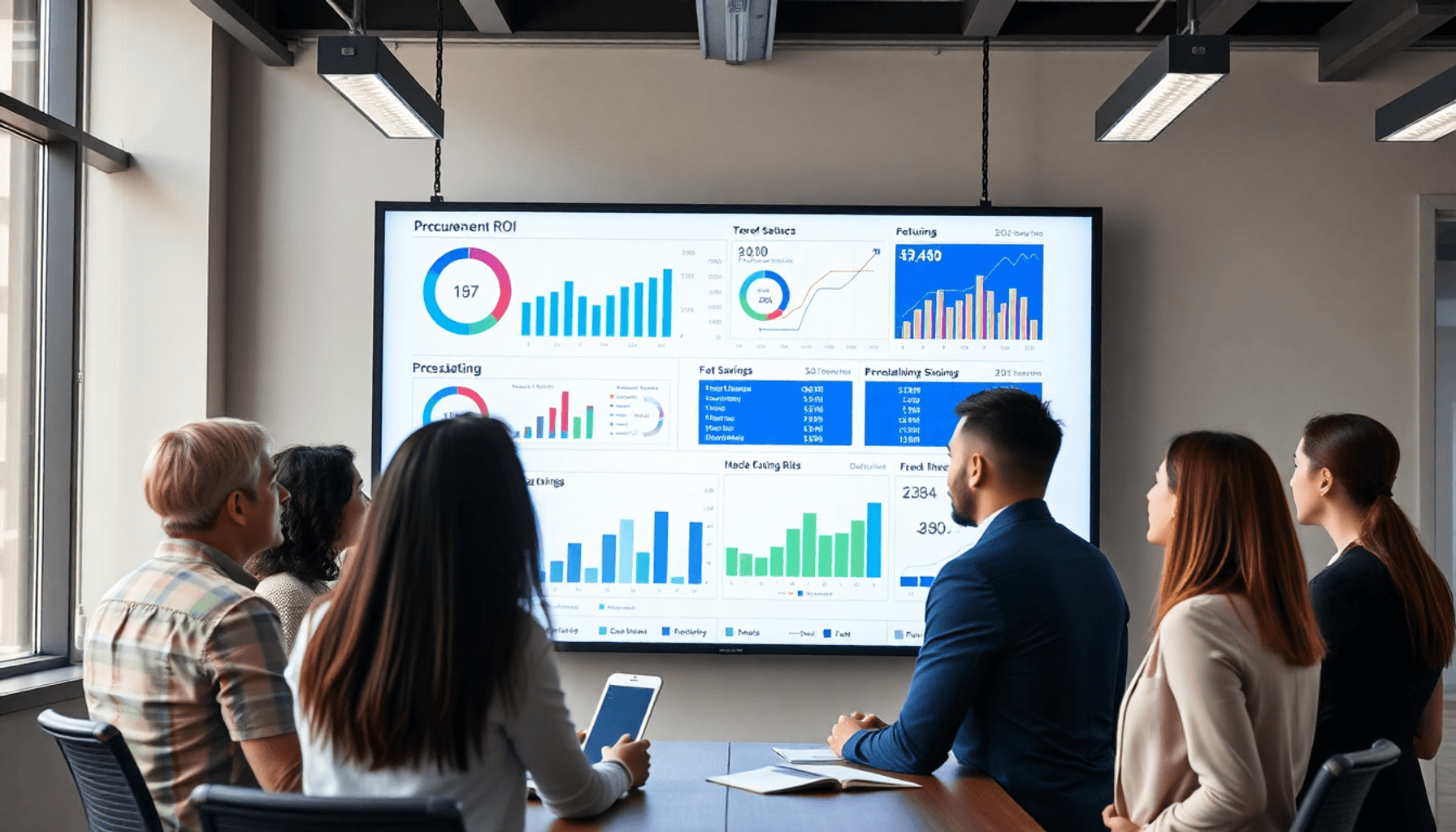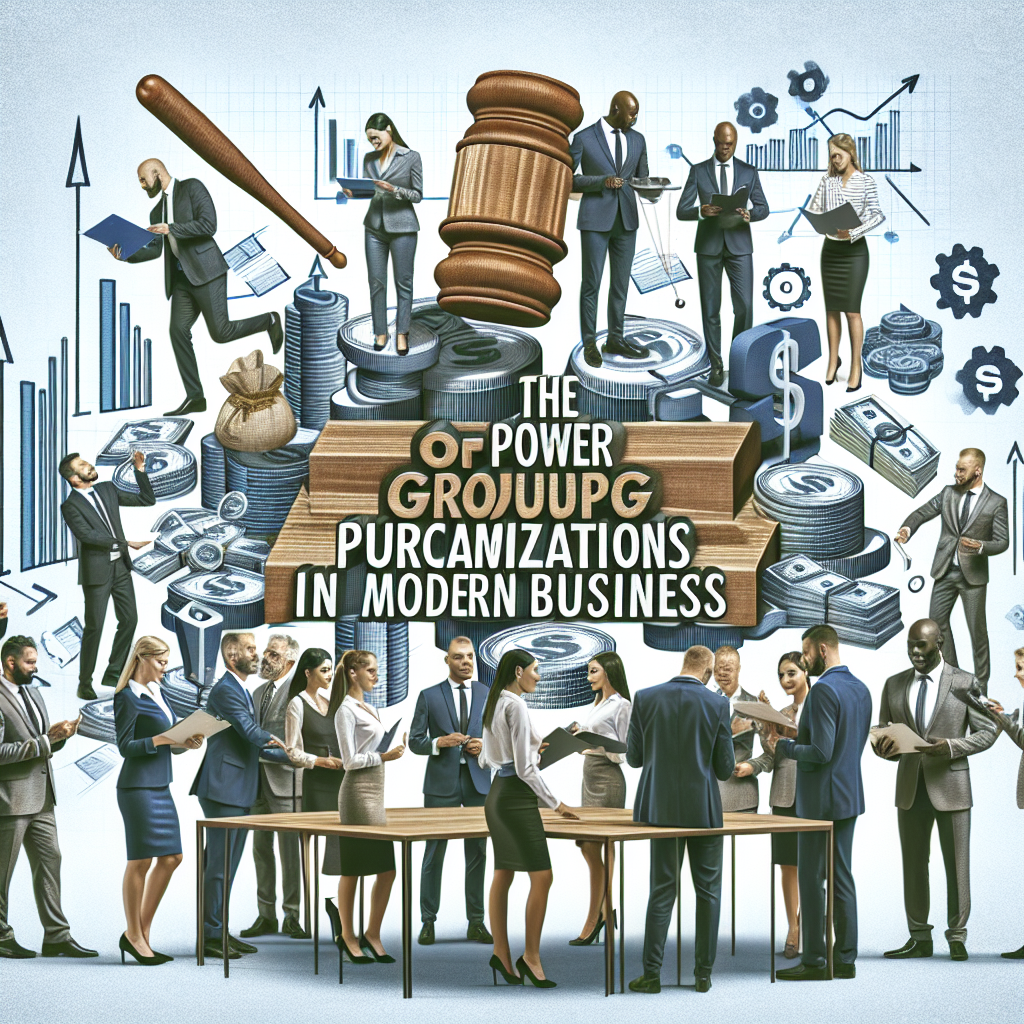Introduction
Procurement ROI measurement is a critical metric that assesses the effectiveness of procurement activities in driving organizational success. Understanding this concept allows businesses to evaluate how procurement strategies contribute to overall performance and financial health.
Key components of procurement ROI include:
- Cost Savings: Identifying reductions in expenses through strategic sourcing and supplier negotiations. This includes exploring compliance-driven sourcing, which can enhance reputation, reduce risks, and align with ethical standards.
- Operational Metrics: Assessing efficiency using key performance indicators (KPIs) such as cycle times and invoice processing costs.
- Value Creation Beyond Financial Gains: Recognizing broader impacts like enhanced supplier relationships and improved cash flow management. It’s essential to avoid certain procurement terms that can hinder effective communication of value.
In this article, we will delve into the importance of procurement ROI measurement. You will learn practical strategies for leveraging analytical tools to calculate and visualize procurement ROI effectively. By mastering these concepts, organizations can make informed decisions that not only enhance cost efficiency but also drive long-term value creation across various business functions.
This journey towards procurement mastery is akin to a life of learning and transformation as exemplified by Frank Corris, who emphasizes continuous learning and strategic thinking in achieving procurement success. Additionally, we will address some common misconceptions in procurement such as those related to GPOs which often lead to misunderstandings about their role in the purchasing process.
Understanding Procurement ROI
Procurement return on investment (ROI) serves as a critical metric for evaluating the effectiveness of procurement initiatives. To grasp its full significance, understanding the procurement ROI formula is essential.
The Procurement ROI Formula
The basic formula for calculating procurement ROI can be expressed as follows:
[ \text{Procurement ROI} = \frac{\text{Cost Savings} – \text{Procurement Costs}}{\text{Procurement Costs}} \times 100 ]
- Cost Savings: This includes all reductions in spending achieved through various procurement strategies.
- Procurement Costs: These are the total costs associated with the procurement function, including staff salaries, technology investments, and overheads.
This formula highlights how effectively your procurement activities convert expenditures into savings.
Application in Real-World Scenarios
In practice, organizations apply this formula to assess various procurement initiatives. For example:
- A company negotiating bulk purchase agreements may calculate cost savings from reduced unit prices.
- An organization that streamlines supplier management processes can quantify efficiencies gained through time savings.
To enhance these procurement strategies further, discovering the best procurement software and outsourcing companies can revolutionize your overall procurement strategy.
Role of Cost Savings and Operational Metrics
Cost savings play a pivotal role in measuring procurement efficiency. However, operational metrics must also be considered for a comprehensive evaluation. Key performance indicators (KPIs) provide additional insights:
- Total Cost per Invoice Processed: Measures the efficiency of processing invoices relative to cost.
- Average Procurement Cycle Time: Tracks the time taken from requisition to delivery, indicating process efficiency.
By analyzing both cost savings and operational metrics, organizations obtain a clearer picture of their procurement performance. This dual focus allows for more informed decision-making and strategic improvements in procurement practices.
Moreover, it is crucial to understand how to build resilience in your procurement strategy during tough times. The article on procurement in crisis provides valuable insights on this topic.
Emphasizing these elements not only enhances financial metrics but also contributes to long-term organizational success. Additionally, integrating Diversity, Equity, and Inclusion (DEI) principles into the procurement process can lead to more innovative solutions and better supplier relationships.
Finally, staying updated with top trends in supplier innovation can provide a competitive edge in the ever-evolving procurement landscape. Such innovations are exemplified by companies like Nike, which have reported significant advancements in their [sustainability
Key Components of Procurement ROI Measurement
1. Cost Savings
Cost savings are a crucial part of measuring procurement ROI. These savings can come in different forms, usually from successful negotiations with suppliers and strategic sourcing initiatives. Understanding the various types of cost savings can give valuable insights into how procurement activities affect an organization’s financial health.
Types of Cost Savings
- Direct Financial Savings: This is the most straightforward type of cost saving. It includes reductions in prices negotiated with suppliers, discounts obtained for bulk purchases, and lower costs achieved through competitive bidding processes.
- Process Efficiency Savings: Streamlining procurement processes can lead to significant time savings and reduced labor costs. For instance, implementing an e-procurement system can automate repetitive tasks, minimizing manual errors and decreasing administrative overhead.
- Supply Chain Optimization: By optimizing inventory levels and improving supplier relationships, organizations can reduce carrying costs and avoid stockouts. Strategic sourcing allows companies to align their purchasing strategies with market conditions, thereby achieving better pricing and delivery terms. This is where procurement optimization plays a vital role.
- Quality Improvements: Investing in higher-quality goods may seem counterintuitive to cost savings. However, superior products can lead to lower defect rates, reduced returns, and increased customer satisfaction, ultimately saving money in the long run.
Importance of Cost Savings
When determining the overall impact of procurement activities on an organization’s bottom line, it is vital to consider these cost savings as they directly influence profitability. Effective procurement strategies not only provide immediate financial relief but also contribute to long-term sustainability through:
- Enhanced Competitive Advantage: Organizations that effectively manage their procurement functions can allocate saved resources towards innovation or expansion projects, enhancing their market position.
- Improved Cash Flow: Lower costs translate to improved cash flow management, allowing businesses to reinvest in growth opportunities or pay down debt more efficiently.
- Strategic Decision Making: Accurate measurement of cost savings enables organizations to make informed decisions regarding supplier selection and sourcing strategies.
Incorporating these elements into your procurement strategy not only enhances the effectiveness of your initiatives but also strengthens the overall financial foundation of your organization. Understanding how each component contributes to procurement ROI measurement will guide future efforts toward maximizing value while maintaining efficiency.
2. Operational Metrics
To measure the return on investment (ROI) of procurement effectively, it’s important to have a good understanding of operational metrics. These metrics act as key performance indicators (KPIs) that provide insights into how well your procurement function is running.
Some essential KPIs include:
-
Total Cost per Invoice Processed: This metric assesses the cost incurred in processing each invoice. A lower cost indicates a more efficient procurement process.
-
Average Procurement Cycle Time: This measures the average time taken from requisition to order fulfillment. Reductions in cycle time can signify enhanced operational efficiency.
By keeping track of these KPIs, organizations can pinpoint areas that need improvement and fine-tune their procurement strategies. Operational metrics not only highlight direct financial savings but also underscore value creation through improved processes.
Understanding these performance indicators equips you to evaluate procurement initiatives effectively. For instance, if you’re managing a one-person procurement function, optimizing your strategy can lead to significant improvements in operational efficiency and cost savings.
Moreover, a deeper understanding of the role of a procurement engineer could provide valuable insights into the strategic sourcing efforts that are crucial for maximizing procurement ROI measurement. It’s worth noting that procurement engineer salary trends are expected to rise in 2025, reflecting the growing importance of this role in driving operational efficiency.
Emphasizing these metrics leads to informed decision-making and enhances the overall performance of your procurement team.
3. Value Creation Beyond Cost Savings
Effective procurement practices extend beyond simple cost savings, influencing broader business objectives. Key areas of impact include:
-
Improved Cash Flow Management: Strategic sourcing enables organizations to negotiate better payment terms with suppliers, enhancing cash flow. This flexibility allows businesses to allocate resources more efficiently, supporting growth initiatives and operational needs.
-
Enhanced Supplier Collaboration: Building strong relationships with suppliers fosters collaboration. This partnership can lead to shared innovations, joint cost-saving initiatives, and streamlined processes. The result is a more resilient supply chain capable of adapting to market changes. For instance, implementing a supplier relationship management program can significantly enhance these collaborations.
Real-world examples highlight how organizations leverage procurement for long-term value creation:
-
Case Study: A Leading Manufacturer implemented a supplier relationship management program that resulted in a 20% reduction in product development time. By collaborating closely with key suppliers, they not only achieved immediate financial benefits but also positioned themselves for future growth through enhanced innovation capabilities.
-
Example: A Government Agency utilized strategic sourcing to consolidate purchases across departments. This approach not only generated significant direct financial savings but also improved operational efficiency by reducing procurement cycle times and minimizing redundancies. Such strategies exemplify the power of leveraging drastic cost reduction through collective spend.
Moreover, it’s crucial to ensure that the suppliers chosen are capable of delivering quality and reliability consistently. Hence, maximizing supplier performance should be an integral part of any procurement strategy.
Performance Measurement in Procurement Teams
Effective procurement teams rely on systematic processes to evaluate their performance rigorously. Organizations implement various methods to measure the effectiveness of their procurement initiatives, ensuring a strong focus on procurement ROI measurement. Key evaluation methods include:
1. Spend Under Management Metrics
This metric assesses the percentage of total spend that is actively managed by the procurement team. Higher percentages indicate better control over expenditures and strategic sourcing efforts.
2. Employee Deliverables Tracking
Evaluating individual contributions within the procurement team helps identify areas for improvement and recognize high performers. Setting clear deliverables ensures accountability and aligns personal goals with organizational targets. To further enhance employee performance, organizations can consider boosting employee morale with break room supplies which can lead to increased productivity.
3. Supplier Performance Assessment
Regularly reviewing supplier performance against established KPIs provides insight into supplier reliability, quality, and pricing. This information aids in making informed decisions about ongoing partnerships.
4. Cost Savings Analysis
Tracking realized cost savings from negotiated contracts offers a direct measure of procurement success. This analysis often reveals trends that can guide future negotiations.
Implementing these evaluation techniques fosters continuous improvement within procurement teams, driving efficiency and enhancing overall organizational performance. The insights gained from these measurements are invaluable in refining strategies and aligning efforts with broader business objectives. Additionally, exploring options such as purchasing groups versus group purchasing organizations could provide valuable insights into strategic sourcing efforts.
Continuous Improvement Strategies for Procurement Practices
Regular performance monitoring is essential for organizations seeking to enhance procurement practices. By consistently evaluating key metrics, businesses can identify areas for improvement related to:
- Cost Savings: Tracking savings from strategic sourcing efforts allows you to assess the financial impact of procurement activities. Implementing effective sourcing strategies can significantly contribute to these savings.
- Operational Efficiency: Monitoring metrics such as cycle times and invoice processing can uncover inefficiencies in procurement processes.
To optimize these areas simultaneously, consider implementing the following strategies:
-
Set Clear KPIs: Define specific, measurable Key Performance Indicators (KPIs) that align with your organization’s goals. This clarity helps ensure that all procurement activities are focused on achieving desired outcomes.
-
Utilize Technology: Leverage analytical tools and software to automate data collection and reporting. Advanced systems can provide real-time insights into spending patterns and operational performance.
-
Engage Stakeholders: Foster collaboration among various departments to gain diverse perspectives on procurement effectiveness. Input from stakeholders can lead to innovative solutions and improved practices.
-
Conduct Regular Reviews: Schedule periodic assessments of procurement strategies and outcomes, allowing you to adjust tactics based on performance data.
-
Benchmark Against Industry Standards: Compare your metrics with industry standards to identify gaps and opportunities for enhancement.
By employing these optimization strategies, organizations position themselves not only to achieve immediate cost savings but also to foster a culture of continuous improvement that drives long-term success in procurement practices. Moreover, it is crucial to develop effective sourcing strategies that not only streamline hiring top talent but also enhance overall operational efficiency. In cases where resources are limited, it’s essential to embrace constraints and optimize processes while leveraging networks for business success.
Aligning Procurement Efforts with Organizational Goals
Strategic alignment between procurement activities and broader business objectives is essential for organizations aiming to enhance their competitive edge. When procurement teams understand and integrate key business goals, they can better contribute to overall organizational success. Consider these aspects:
1. Risk Mitigation
Aligning procurement with risk management ensures that sourcing decisions account for supply chain vulnerabilities, regulatory compliance, and market fluctuations.
2. Innovation Enhancement
Strategic procurement can foster innovation by partnering with suppliers who offer advanced technologies or sustainable practices, driving value beyond mere cost savings.
Effective measurement frameworks play a pivotal role in achieving this alignment. By establishing clear metrics tied to both procurement performance and organizational goals, companies gain insights into how well their procurement strategies are supporting broader initiatives.
For instance, tracking supplier performance against innovation benchmarks can reveal opportunities for improvement and collaboration. Regularly updating these metrics allows organizations to adapt to evolving business landscapes, ensuring procurement remains a vital contributor to strategic objectives.
Leveraging Analytical Tools for Accurate Procurement ROI Calculation
Achieving accurate procurement ROI measurement requires the right analytical tools. These resources enhance data-driven decision-making, enabling organizations to visualize their procurement performance effectively. Here are some popular analytical tools that can aid in this process:
- Coupa: This platform offers comprehensive spend analytics, helping organizations identify savings opportunities and track procurement efficiency.
- SAP Ariba: Known for its robust data management capabilities, SAP Ariba allows users to analyze supplier performance and procurement processes in real-time.
- Oracle Procurement Cloud: This tool integrates advanced analytics to help businesses understand their spending patterns and optimize supplier relationships.
- Jaggaer: Focused on delivering actionable insights, Jaggaer provides users with intuitive dashboards that highlight key metrics related to procurement ROI.
Using these tools empowers organizations to measure and visualize their procurement effectiveness accurately. Implementing analytics not only quantifies traditional cost savings but also captures value creation aspects such as improved supplier collaboration and operational efficiency. By leveraging these technologies, you position your organization for enhanced decision-making capabilities and strategic insights, driving better procurement outcomes.
Case Study Example: Hubzone Depot LLC’s Success Story in Measuring Procurement ROI Effectively Through Strategic Approaches And Innovative Solutions
Hubzone Depot LLC serves as a compelling case study in the realm of procurement ROI measurement. As a certified HUBZone small business founded by Jessica S. Presco, this organization specializes in supplying services to public sector clients. The company exemplifies how systematic measurement and innovative solutions can drive substantial value over time.
Key Strategies Employed by Hubzone Depot
1. Systematic Measurement Approaches
Hubzone Depot utilizes advanced monitoring systems and benchmarking against purchasing trends, allowing them to track performance meticulously. This data-driven approach enhances their ability to demonstrate cost savings and operational efficiencies.
2. Innovative Solutions
By leveraging Group Purchasing Organizations (GPO), they gain access to competitive pricing and bulk buying power, which translates into immediate cost reductions for their clients. This strategy not only benefits public sector clients but also showcases the private sector group purchasing benefits that can be realized through such partnerships.
3. Tail Spend Management
The company also focuses on tail spend management, ensuring that even the smaller purchases are optimized for savings and efficiency.
4. Transparent Reporting
The company’s commitment to transparent reporting reinforces trust with clients. This practice not only showcases savings achieved but also highlights opportunities for continuous improvement.
Insights for Other Organizations
-
Holistic Measurement Framework: Organizations should adopt a comprehensive framework that emphasizes both cost savings and operational metrics. This dual focus allows for a more accurate assessment of procurement effectiveness.
-
Value Beyond Financial Gains: Effective procurement practices should align with broader business objectives such as risk mitigation and supplier collaboration. Hubzone Depot’s success illustrates the importance of considering long-term value creation alongside immediate financial benefits.
-
Commitment to Compliance: Maintaining HUBZone compliance through rigorous verification processes demonstrates the significance of adherence to regulations in maximizing procurement ROI.
-
Strategic Sourcing vs Category Management: Understanding the difference between strategic sourcing and category management can provide organizations with insights into optimizing their procurement processes.
-
Maximizing Federal Grant Funding for Nonprofits: For nonprofit organizations, learning how to maximize federal grant funding can significantly enhance their operational capabilities.
-
Entry-Level Procurement Jobs: Aspiring professionals looking to kickstart their career in supply chain can find valuable information about entry-level procurement jobs that can serve as a stepping stone into the industry.
Call to Action
Organizations seeking to enhance their procurement ROI measurement can learn from Hubzone Depot’s example. Embrace innovative strategies like tail spend management and implement systematic approaches that not only focus on savings but also drive broader organizational goals such as risk mitigation and supplier collaboration. Adopting such holistic practices within an inclusive supply chain ecosystem will enable businesses to unlock significant value from their strategic sourcing initiatives, ultimately resulting in





